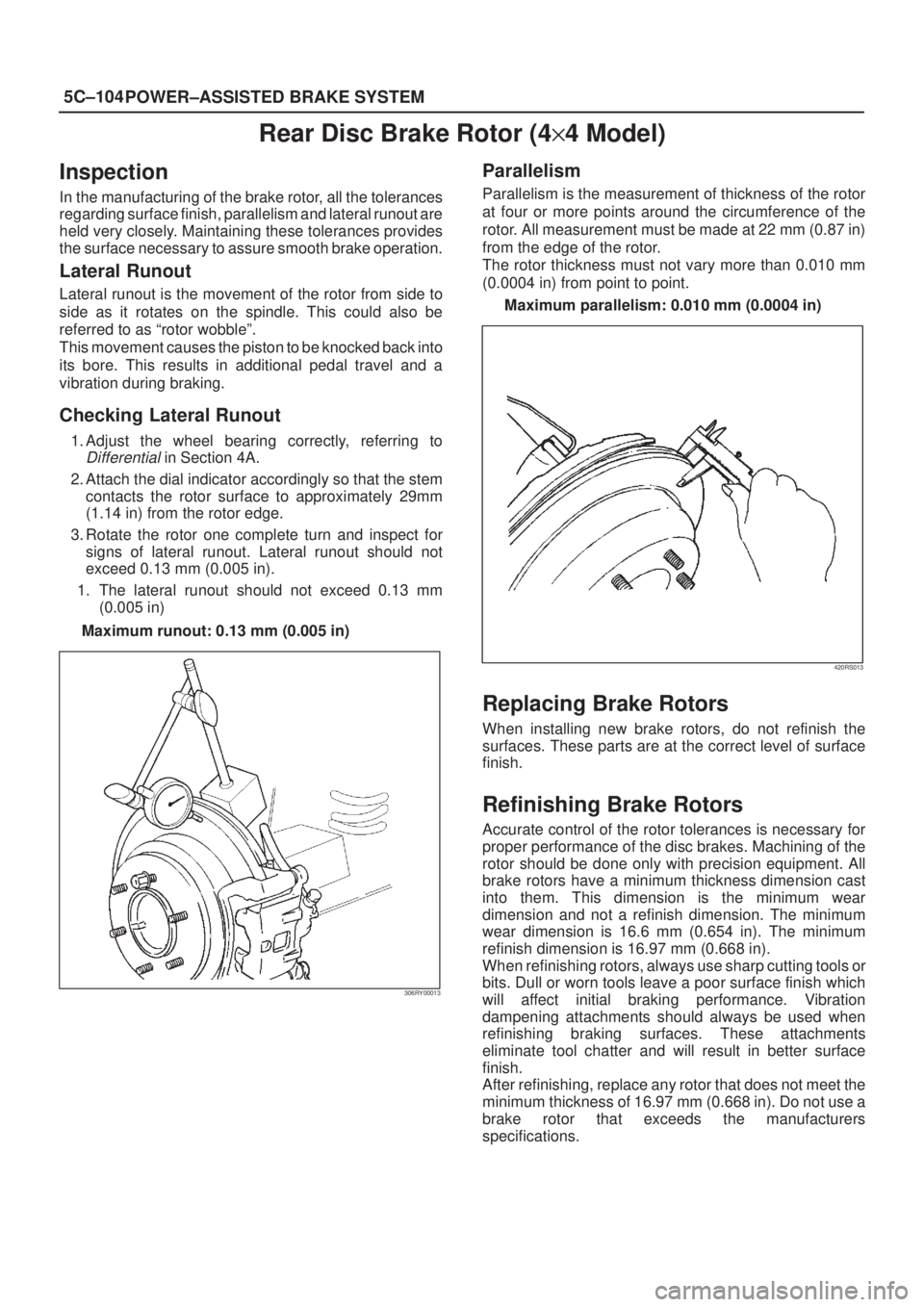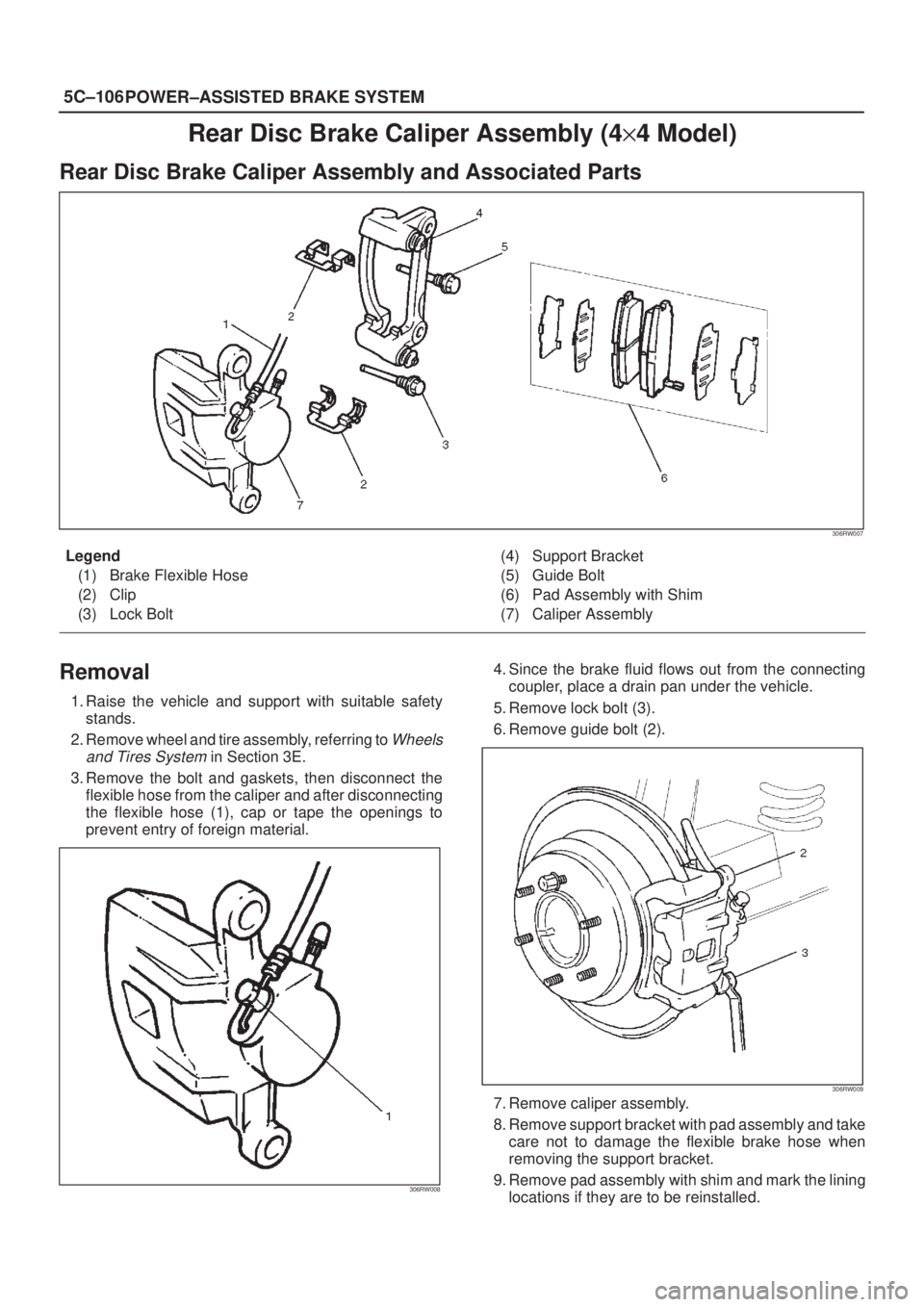Page 773 of 2100

5C±93 POWER±ASSISTED BRAKE SYSTEM
Front Disc Brake Rotor
Inspection
In the manufacturing of the brake rotor, all the tolerances
regarding surface finish, parallelism and lateral runout are
held very closely. Maintaining these tolerances provides
the surface necessary to assure smooth brake operation.
Lateral Runout
Lateral runout is the movement of the rotor from side to
side as it rotates on the spindle. This could also be
referred to as ªrotor wobbleº.
This movement causes the piston to be knocked back into
its bore. This results in additional pedal travel and a
vibration during braking.
Checking Lateral Runout
1. Adjust the wheel bearing correctly, refer to Differential
in Section 4A.
2. Attach the dial indicator accordingly so that the stem
contacts the rotor surface to approximately 29mm
(1.14 in) from the rotor edge.
3. Rotate the rotor one complete turn and inspect for
signs of lateral runout. Lateral runout should not
exceed 0.13 mm (0.005 in).
Maximum runout: 0.13 mm (0.005 in)
411R200008
Parallelism
Parallelism is the measurement of thickness of the rotor
at four or more points around the circumference of the
rotor. All measurement must be made at 29 mm (1.14 in)
from the edge of the rotor.
The rotor thickness must not vary more than 0.010 mm
(0.0004 in) from point to point.
Maximum runout: 0.010 mm (0.0004 in)
411R200007
Replacing Brake Rotors
When installing new brake rotors, do not refinish the
surfaces. These parts are at the correct level of surface
finish.
Refinishing Brake Rotors
Accurate control of the rotor tolerances is necessary for
proper performance of the disc brakes. Machining of the
rotor should be done only with precision equipment. All
brake rotors have a minimum thickness dimension cast
into them. This dimension is the minimum wear
dimension and not a refinish dimension. The minimum
wear dimension is 24.60 mm (0.969 in). The minimum
refinish dimension is 26.00 mm (1.024 in).
When refinishing rotors, always use sharp cutting tools or
bits. Dull or worn tools leave a poor surface finish which
will affect initial braking performance. Vibration
dampening attachments should always be used when
refinishing braking surfaces. These attachments
eliminate tool chatter and will result in better surface
finish.
After refinishing, replace any rotor that does not meet the
minimum thickness of 26.00 mm (1.024 in). Do not use a
brake rotor that exceeds the manufacturers
specifications.
Page 775 of 2100
5C±95 POWER±ASSISTED BRAKE SYSTEM
Front Disc Brake Caliper Assembly
Front Disc Brake Caliper Assembly and Associated Parts
302R200027
Legend
(1) Brake Flexible Hose
(2) Pin Bolt
(3) Caliper Assembly(4) Pad Assembly
(5) Clip
(6) Support Bracket with Pad Assembly
(7) Outer Side
Removal
1. Raise the vehicle and support with suitable safety
stands.
2. Remove wheel and tire assembly, refer to
Wheels
and Tires System
in Section 3E.
3. Remove the bolt and gaskets, then disconnect the
flexible hose from the caliper and after disconnecting
the flexible hose (1), cap or tape the openings to
prevent entry of foreign material.
302R200007
Page 777 of 2100
5C±97 POWER±ASSISTED BRAKE SYSTEM
4. Install caliper assembly.
5. Install pin bolt (8) and tighten the bolt to the specified
torque.
Torque: 45 N´m (33 lb ft)
302R200010
6. Install brake flexible hose, always use new gaskets
and be sure to put the hooked edge of the flexible
hose end into the anti±rotation cavity then tighten the
I±bolt (9) to the specified torque.
Torque: 35 N´m (26 lb ft)
302R200021
7. Install wheel and tire assembly, referring to Wheels
and Tires System
in Section 3E.
8. Bleed brakes. Refer to
Hydraulic Brakes in this
section.
Page 782 of 2100
5C±102
POWER±ASSISTED BRAKE SYSTEM
Removal
NOTE: If a squealing noise occurs from the rear brake
while driving, check the pad wear indicator plate. If the
indicator plate contacts the rotor, the disc pad assembly
should be replaced.
�Draw out two±thirds of the brake fluid from the
reservoir.
�Raise the vehicle and support it with suitable safety
stands.
1. Remove wheel and tire assembly, referring to
Wheels
and Tires System
in Section 3E.
2. Remove lock bolt (1)
306RW002
3. Rotate caliper assembly and support the caliper
assembly so that the brake hose is not stretched or
damaged.
4. Remove pad assembly with shim.
5. Remove clip.
Installation
1. Install clip (2).
306RW003
2. Apply special grease (approximately 0.2 g) to both
contacting surfaces of the inner shims. Wipe off
extruded grease after installing. Install pad assembly
with shim.
306RW004
Legend
(3) Inner Shim
(4) Wear Indicator
Page 783 of 2100
5C±103 POWER±ASSISTED BRAKE SYSTEM
306RW005
3. Carefyully use adjustable pliers to bottom the piston
into the caliper bore. Do not pull or twist the flex hose
or damage will occur.
302RS008
4. Install lock bolt (5) and tighten the bolt to the specified
torque.
Torque: 44 N´m (32 lb ft)
306R200003
5. Install wheel and tire assembly, referring to Wheels
and Tires System
in Section 3E.
6. Pump the brake pedal several times to make sure that
the pedal is firm. Check the brake fluid level in the
reservoir after pumping the brakes.
Page 784 of 2100

5C±104
POWER±ASSISTED BRAKE SYSTEM
Rear Disc Brake Rotor (4y4 Model)
Inspection
In the manufacturing of the brake rotor, all the tolerances
regarding surface finish, parallelism and lateral runout are
held very closely. Maintaining these tolerances provides
the surface necessary to assure smooth brake operation.
Lateral Runout
Lateral runout is the movement of the rotor from side to
side as it rotates on the spindle. This could also be
referred to as ªrotor wobbleº.
This movement causes the piston to be knocked back into
its bore. This results in additional pedal travel and a
vibration during braking.
Checking Lateral Runout
1. Adjust the wheel bearing correctly, referring to
Differential in Section 4A.
2. Attach the dial indicator accordingly so that the stem
contacts the rotor surface to approximately 29mm
(1.14 in) from the rotor edge.
3. Rotate the rotor one complete turn and inspect for
signs of lateral runout. Lateral runout should not
exceed 0.13 mm (0.005 in).
1. The lateral runout should not exceed 0.13 mm
(0.005 in)
Maximum runout: 0.13 mm (0.005 in)
306RY00013
Parallelism
Parallelism is the measurement of thickness of the rotor
at four or more points around the circumference of the
rotor. All measurement must be made at 22 mm (0.87 in)
from the edge of the rotor.
The rotor thickness must not vary more than 0.010 mm
(0.0004 in) from point to point.
Maximum parallelism: 0.010 mm (0.0004 in)
420RS013
Replacing Brake Rotors
When installing new brake rotors, do not refinish the
surfaces. These parts are at the correct level of surface
finish.
Refinishing Brake Rotors
Accurate control of the rotor tolerances is necessary for
proper performance of the disc brakes. Machining of the
rotor should be done only with precision equipment. All
brake rotors have a minimum thickness dimension cast
into them. This dimension is the minimum wear
dimension and not a refinish dimension. The minimum
wear dimension is 16.6 mm (0.654 in). The minimum
refinish dimension is 16.97 mm (0.668 in).
When refinishing rotors, always use sharp cutting tools or
bits. Dull or worn tools leave a poor surface finish which
will affect initial braking performance. Vibration
dampening attachments should always be used when
refinishing braking surfaces. These attachments
eliminate tool chatter and will result in better surface
finish.
After refinishing, replace any rotor that does not meet the
minimum thickness of 16.97 mm (0.668 in). Do not use a
brake rotor that exceeds the manufacturers
specifications.
Page 786 of 2100

5C±106
POWER±ASSISTED BRAKE SYSTEM
Rear Disc Brake Caliper Assembly (4y4 Model)
Rear Disc Brake Caliper Assembly and Associated Parts
306RW007
Legend
(1) Brake Flexible Hose
(2) Clip
(3) Lock Bolt(4) Support Bracket
(5) Guide Bolt
(6) Pad Assembly with Shim
(7) Caliper Assembly
Removal
1. Raise the vehicle and support with suitable safety
stands.
2. Remove wheel and tire assembly, referring to
Wheels
and Tires System
in Section 3E.
3. Remove the bolt and gaskets, then disconnect the
flexible hose from the caliper and after disconnecting
the flexible hose (1), cap or tape the openings to
prevent entry of foreign material.
306RW008
4. Since the brake fluid flows out from the connecting
coupler, place a drain pan under the vehicle.
5. Remove lock bolt (3).
6. Remove guide bolt (2).
306RW009
7. Remove caliper assembly.
8. Remove support bracket with pad assembly and take
care not to damage the flexible brake hose when
removing the support bracket.
9. Remove pad assembly with shim and mark the lining
locations if they are to be reinstalled.
Page 788 of 2100
5C±108
POWER±ASSISTED BRAKE SYSTEM
302RW017
7. Install the wheel and tire assembly, referring to
Wheels and Tires System in Section 3E.
8. Bleed brakes. Refer to
Hydraulic Brakes in this
section.
Rear Disc Brake Caliper (4y4 Model)
Rear Disc Brake Caliper Disassembled View
306RW014
Legend
(1) Guide Bolt
(2) Lock Bolt
(3) Bleeder with Cap
(4) Caliper Body(5) Piston Seal
(6) Piston
(7) Dust Boot: Piston
(8) Dust Boot Ring
(9) Dust Boot: Guide Bolt and Lock Bolt